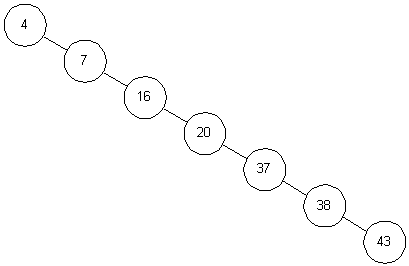Binary search tree: find: Difference between revisions
| Line 18: | Line 18: | ||
== Abstract view == | == Abstract view == | ||
'''Invariant:''' After <math>i\geq 0</math> Iterations. | '''Invariant:''' After <math>i\geq 0</math> Iterations. | ||
# The pointer | # The pointer <math>p</math> points to a tree node <math>v</math> on height level <math>i</math> (or is void). | ||
# The key | # The key <math>K</math> is in the [[Directed Tree#Ranges of Search Tree Nodes|range]] of <math>v'</math>. | ||
'''Variant:''' | '''Variant:''' <math>i</math> is increased by 1. | ||
'''Break condition:''' Either it is <math>p = void</math> or, otherwise, <math>p.key = K</math>. | '''Break condition:''' Either it is <math>p = void</math> or, otherwise, <math>p.key = K</math>. | ||
Revision as of 09:31, 17 May 2015
General Information
Algorithmic Problem: Sorted Sequence:find
Type of algorithm: loop
Auxiliary data: A pointer [math]\displaystyle{ p }[/math] of type "pointer to binary search tree node of type [math]\displaystyle{ \mathcal{K} }[/math]."
Abstract view
Invariant: After [math]\displaystyle{ i\geq 0 }[/math] Iterations.
- The pointer [math]\displaystyle{ p }[/math] points to a tree node [math]\displaystyle{ v }[/math] on height level [math]\displaystyle{ i }[/math] (or is void).
- The key [math]\displaystyle{ K }[/math] is in the range of [math]\displaystyle{ v' }[/math].
Variant: [math]\displaystyle{ i }[/math] is increased by 1.
Break condition: Either it is [math]\displaystyle{ p = void }[/math] or, otherwise, [math]\displaystyle{ p.key = K }[/math].
Induction basis
Abstract view: Set p:= root.
Implementation: Obvious
Proof: Nothing to show
Induction step
Abstract view: If p points to a node but not with key K, p descends in the appropriate direction, left or right.
Implementation:
- If [math]\displaystyle{ p = void }[/math], terminate the algorithm and return false.
- Otherwise, if [math]\displaystyle{ p.key = K }[/math], terminate the algorithm and return true.
- Otherwise:
- If [math]\displaystyle{ K \lt p.key }[/math], set [math]\displaystyle{ p := left }[/math].
- If [math]\displaystyle{ K \gt p.key }[/math], set [math]\displaystyle{ p := right }[/math].
Correctnes: Obvious.
Complexity
Statement: Linear in the length of the sequence in the worst case (more precisely, linear in the height of the tree).
Proof: Obvious.
Pseudocode
TREE-SEARCH (x, k)
- if x= NIL or k = key[x]
- then return x
- if k < key[x]
- then return TREE-SEARCH(left[x], k)
- else return TREE-SEARCH(right[x], k)
